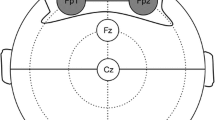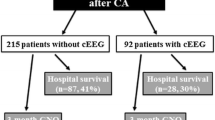Abstract
Objective
To evaluate the use of continuous amplitude-integrated EEG (aEEG) as a prognostic tool for survival and neurological outcome in cardiac arrest patients treated with hypothermia.
Design
Prospective, observational study.
Setting
Multidisciplinary intensive care unit in a university hospital.
Intervention
Comatose survivors of cardiac arrest were treated with induced hypothermia for 24 h. An aEEG recording was initiated upon arrival at the ICU and continued until the patient regained consciousness or, if the patient remained in coma, no longer than 120 h. The aEEG recording was not available to the ICU physician, and the aEEG tracings were interpreted by a neurophysiologist with no knowledge of the patient's clinical status. Only clinically visible seizures were treated.
Measurements and results
Thirty-four consecutive hypothermia-treated cardiac arrest survivors were included. At normothermia (mean 37 h after cardiac arrest), the aEEG pattern was discriminative for outcome. All 20 patients with a continuous aEEG at this time regained consciousness, whereas 14 patients with pathological aEEG patterns (flat, suppression-burst or status epilepticus) did not regain consciousness and died in hospital. Patients were evaluated neurologically upon discharge from the ICU and after 6 months, using the Cerebral Performance Category (CPC) scale. Eighteen patients were alive with a good cerebral outcome (CPC 1--2) at 6-month follow-up.
Conclusion
A continuous aEEG pattern at the time of normothermia was discriminative for regaining consciousness. aEEG is an easily applied method in the ICU setting.


Similar content being viewed by others
References
Herlitz J, Bång A, Gunnarsson J, Engdahl J, Karlsson BW, Lindqvist J, Waagstein L (2003) Factors associated with survival to hospital discharge among patients hospitalised alive after out of hospital cardiac arrest: change in outcome over 20 years in the community of Göteborg, Sweden. Heart 89:25–30
Zandbergen EGJ, de Haan RJ, Stoutenbeek CP, Koelman JHTM, Hijdra A (1998) Systematic review of early prediction of poor outcome in anoxic-ischaemic coma. Lancet 352:1808–1812
Martens P, Raabe A, Johnsson P (1998) Serum S-100 and neuron-specific enolase for prediction of regaining consciousness after global cerebral ischemia. Stroke 29:2363–2366
Meynaar IA, Oudemans-van Straaten HM, Wetering J, Verlooy P, Slaats EH, Bosman RJ, Spoel JI, Zandstra DF (2003) Serum neuron-specific enolase predicts outcome in post-anoxic coma: a prospective cohort study. Intensive Care Med 29:189–195
Rosén H, Stilbrant Sunnerhagen K, Herlitz J, Blomstrand C, Rosengren L (2001) Serum levels of the brain-derived proteins S-100 and NSE predict long-term outcome after cardiac arrest. Resuscitation 49:183–191
Binnie CD, Prior PF, Lloyd DSL, Scott DF, Margerison JH (1970) Electroencephalographic prediction of fatal anoxic brain damage after resuscitation from cardiac arrest. Br Med J 4:265–268
Jorgensen EO, Holm S (1998) The natural course of neurological recovery following cardiopulmonary resuscitation. Resuscitation 36:111–122
Madl C, Kramer L, Domanovits H, Woolard RH, Gervais H, Gendo A, Eisenhuber E, Grimm G, Sterz F (2000) Improved outcome prediction in unconscious cardiac arrest survivors with sensory evoked potentials compared with clinical assessment. Crit Care Med 28:721–726
Pfeifer R, Börner A, Krack A, Sigusch HH, Surber R, Figulla HR (2005) Outcome after cardiac arrest: predictive values and limitations of the neuroproteins neuron-specific enolase and protein S-100 and the Glasgow Coma Scale. Resuscitation 65:49–55
Young GB, Doig G, Ragzzoni A (2005) Anoxic-ischemic encephalopathy: clinical and electrophysiologic associations with outcome. Neurocritical Care 2:159–164
Edgren E, Hedstrand U, Kelsey S, Sutton-Tyrell K, Safar P (1994) Assessment of neurological prognosis in comatose survivors of cardiac arrest. BRCT I study group. Lancet 343:1055–1059
Levy DE, Caronna JJ, Singer BH, Lapinski RH, Frydman H, Plum F (1985) Predicting outcome from hypoxic-ischemic coma. JAMA 253:1420–1426
Booth CM, Boone RH, Tomlinson G, Detsky AS (2004) Is this patient dead, vegetative, or severely neurologically impaired? JAMA 291:870–879
Maramattom BV, Wijdicks EFM (2005) Postresuscitation encephalopathy: current views, management and prognostication. The Neurologist 11:234–243
Bernard SA, Gray TW, Buist MD, Jones BM, Silvester W, Gutteridge G, Smith K (2002) Treatment of comatose survivors of out-of-hospital cardiac arrest with induced hypothermia. N Engl J Med 346:557–563
The hypothermia after cardiac arrest study group (2002) Mild therapeutic hypothermia to improve the neurologic outcome after cardiac arrest. N Engl J Med 346:549–556
Hossmann KA, Kleihues P (1973) Reversibility of ischemic brain damage. Arch Neurol 29:375–384
Rehncrona S, Rosén I, Smith ML (1985) Effect of different degrees of brain ischemia and tissue lactic acidosis on the short-term recovery of neurophysiologic and metabolic variables. Exp Neurol 87:458–473
Rosén I, Smith ML, Rehncrona S (1984) Quantitative EEG and evoked potentials after experimental brain ischemia in the rat; correlation with cerebral metabolism and blood flow. Prog Brain Res 62:175–183
Snyder BD, Hauser WA, Loewenson RB, Leppik IE, Ramirez-Lassepas M, Gumnit RJ (1980) Neurologic prognosis after cardiopulmonary arrest. III. Seizure activity. Neurology 30:1292–1297
Thorngren-Jerneck K, Hellström-Westas L, Ryding E, Rosén I (2003) Cerebral glucose metabolism and early EEG/aEEG in term newborn infants with hypoxic-ischemic encephalopathy. Pediatr Res 54:854–860
Toet MC, Hellström-Westas L, Groenendaal F, Eken P, de Vries LS (1999) Amplitude integrated EEG 3 and 6 hours after birth in full term neonates with hypoxic ischaemic encephalopathy. Arch Dis Child Fetal Neonatal Ed 81:19–23
van Rooij LGM, Toet MC, Osredkar D, van Huffelen AC, Groenendaal F, de Vries LS (2005) Recovery of amplitude integrated electroencephalographic background patterns within 24 hours of perinatal asphyxia. Arch Dis Child Fetal Neonatal Ed 90:F245–F251
Gluckman PD, Wyatt JS, Azzopardi D, Ballard R, Edwards AD, Ferriero DM, Polin RA, Robertson CM, Thoresen M, Whitelaw A, Gunn AJ, on behalf of the CoolCap study group (2005) Selective head cooling with mild systemic hypothermia after neonatal encephalopathy: multicentre randomised trial. Lancet 365:663–670
Bernard S, Buist M, Monteiro O, Smith K (2003) Induced hypothermia using large volume, ice-cold intravenous fluid in comatose survivors of out-of-hospital cardiac arrest: a preliminary report. Resuscitation 56:9–13
Jennett B, Bond M (1975) Assessment of outcome after severe brain damage. Lancet i:480–484
Young GB (2000) The EEG in coma. J Clin Neurophysiol 17:473–485
Stecker MM, Cheung AT, Pochettino A, Kent GP, Patterson T, Weiss SJ, Bavaria JE (2001) Deep hypothermic circulatory arrest: I. Effects of cooling on electroencephalogram and evoked potentials. Ann Thorac Surg 71:14–21
Krumholz A, Stern BJ, Weiss HD (1988) Outcome from coma after cardiopulmonary resuscitation: relation to seizures and myoclonus. Neurology 38:401–405
Tiainen M, Roine RO, Pettilä V, Takkunen O (2003) Serum neuron-specific enolase and S-100B protein in cardiac arrest patients treated with hypothermia. Stroke 34:2881–2886
Tiainen M, Kovala TT, Takkunen OS, Roine RO (2005) Somatosensory and brainstem auditory evoked potentials in cardiac arrest patients treated with hypothermia. Crit Care Med 33:1736–1740
Hachimi-Idrissi S, Zizi M, Nguyen DN, Schiettecate J, Ebinger G, Michotte Y, Huyghens L (2005) The evolution of serum astroglial S-100B protein in patients with cardiac arrest treated with mild hypothermia. Resuscitation 64:187–192
Acknowledgements
This study was supported by the Swedish Research Council, grant No. 84 (Ingmar Rosén). We would like to thank Bodil Persson, EEG technician, for excellent technical support. The assistance of Gisela Railo, occupational therapist, Dr Tobias Cronberg and Dr Håkan Widner at the Department of Neurology, Lund University Hospital is gratefully acknowledged.
Author information
Authors and Affiliations
Corresponding author
Rights and permissions
About this article
Cite this article
Rundgren, M., Rosén, I. & Friberg, H. Amplitude-integrated EEG (aEEG) predicts outcome after cardiac arrest and induced hypothermia. Intensive Care Med 32, 836–842 (2006). https://doi.org/10.1007/s00134-006-0178-6
Received:
Accepted:
Published:
Issue Date:
DOI: https://doi.org/10.1007/s00134-006-0178-6




